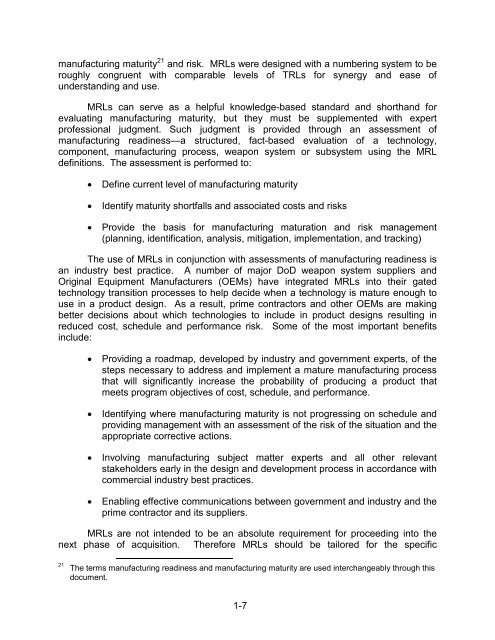Manufacturing Readiness Level (MRL) Deskbook
Manufacturing Readiness Level (MRL) Deskbook
Manufacturing Readiness Level (MRL) Deskbook
- No tags were found...
You also want an ePaper? Increase the reach of your titles
YUMPU automatically turns print PDFs into web optimized ePapers that Google loves.
manufacturing maturity 21 and risk. <strong>MRL</strong>s were designed with a numbering system to beroughly congruent with comparable levels of TRLs for synergy and ease ofunderstanding and use.<strong>MRL</strong>s can serve as a helpful knowledge-based standard and shorthand forevaluating manufacturing maturity, but they must be supplemented with expertprofessional judgment. Such judgment is provided through an assessment ofmanufacturing readiness—a structured, fact-based evaluation of a technology,component, manufacturing process, weapon system or subsystem using the <strong>MRL</strong>definitions. The assessment is performed to:• Define current level of manufacturing maturity• Identify maturity shortfalls and associated costs and risks• Provide the basis for manufacturing maturation and risk management(planning, identification, analysis, mitigation, implementation, and tracking)The use of <strong>MRL</strong>s in conjunction with assessments of manufacturing readiness isan industry best practice. A number of major DoD weapon system suppliers andOriginal Equipment Manufacturers (OEMs) have integrated <strong>MRL</strong>s into their gatedtechnology transition processes to help decide when a technology is mature enough touse in a product design. As a result, prime contractors and other OEMs are makingbetter decisions about which technologies to include in product designs resulting inreduced cost, schedule and performance risk. Some of the most important benefitsinclude:• Providing a roadmap, developed by industry and government experts, of thesteps necessary to address and implement a mature manufacturing processthat will significantly increase the probability of producing a product thatmeets program objectives of cost, schedule, and performance.• Identifying where manufacturing maturity is not progressing on schedule andproviding management with an assessment of the risk of the situation and theappropriate corrective actions.• Involving manufacturing subject matter experts and all other relevantstakeholders early in the design and development process in accordance withcommercial industry best practices.• Enabling effective communications between government and industry and theprime contractor and its suppliers.<strong>MRL</strong>s are not intended to be an absolute requirement for proceeding into thenext phase of acquisition. Therefore <strong>MRL</strong>s should be tailored for the specific21The terms manufacturing readiness and manufacturing maturity are used interchangeably through thisdocument.1-7
















